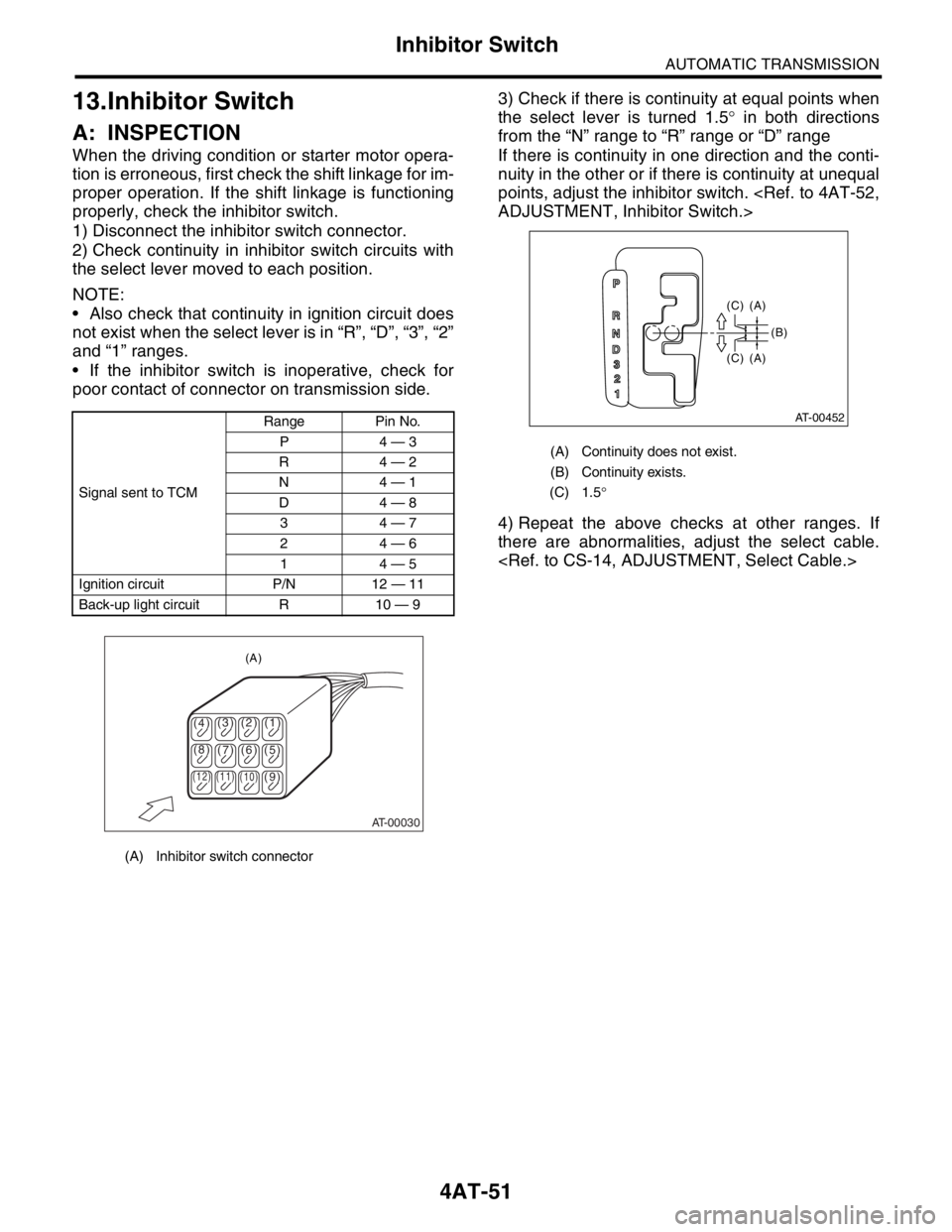2004 SUBARU FORESTER ignition
[x] Cancel search: ignitionPage 2278 of 2870

EN(H4DOTC 2.5)-254
ENGINE (DIAGNOSTIC)
Diagnostic Procedure with Diagnostic Trouble Code (DTC)
Step Check Yes No
1 CHECK ACCELERATOR PEDAL POSITION
SENSOR OUTPUT.
1) Turn the ignition switch to ON.
2) Measure the voltage between ECM con-
nector and terminal.
Connector & terminal
(B136) No. 17 (+) — (B136) No. 34 (
−):
(B136) No. 28 (+) — (B136) No. 35 (
−):
3) Check the voltage change by shaking the
harness and connector of ECM and accelera-
tor pedal position sensor connector and har-
ness.Is the voltage more than 0.4 V? Go to step 2.Go to step 3.
2 CHECK POOR CONTACT.
Check poor contact in connector between
ECM and accelerator pedal position sensor.Is there poor contact? Repair the poor
contact.Go to step 12.
3 CHECK HARNESS BETWEEN ECM AND AC-
CELERATOR PEDAL POSITION SENSOR.
1) Turn the ignition switch to OFF.
2) Disconnect the connector from ECM.
3) Disconnect the connector from the acceler-
ator pedal position sensor.
4) Measure the resistance between ECM con-
nector and accelerator pedal position sensor con-
nector.
Connector & terminal
(B136) No. 15 — (B315) No. 3:
(B136) No. 16 — (B315) No. 1:
(B136) No. 17 — (B315) No. 5:
(B136) No. 28 — (B315) No. 2:Is the resistance less than 1
Ω?Go to step 4.Repair the open
circuit of harness
connector.
4 CHECK HARNESS BETWEEN ECM AND AC-
CELERATOR PEDAL POSITION SENSOR.
Measure the resistance between ECM connec-
tor and chassis ground.
Connector & terminal
(B136) No. 15 — Chassis ground:
(B136) No. 16 — Chassis ground:
(B136) No. 17 — Chassis ground:
(B136) No. 28 — Chassis ground:Is the resistance more than 1
MΩ?Go to step 5.Repair the ground
short circuit of har-
ness.
5 CHECK POWER SUPPLY OF ACCELERA-
TOR PEDAL POSITION SENSOR.
1) Connect the ECM connector.
2) Turn the ignition switch to ON.
3) Measure the voltage between accelerator
pedal position sensor connector and engine
ground.
Connector & terminal
(B315) No. 3 (+) — Engine ground (
−):
(B315) No. 1 (+) — Engine ground (
−):
4) Check the voltage change by shaking the
harness and connector of ECM while monitor-
ing the value with voltage meter.Is the voltage 4.5 — 5.5 V? Go to step 6.Repair the poor
contact in ECM con-
nector. Replace the
ECM if defective.
6 CHECK ACCELERATOR PEDAL POSITION
SENSOR.
Measure the resistance of accelerator pedal
position sensor.
Te r m i n a l s
No. 3 — No. 4:Is the resistance 1.2 — 4.8
kΩ?Go to step 7.Replace the accel-
erator pedal posi-
tion sensor.
Page 2279 of 2870

EN(H4DOTC 2.5)-255
ENGINE (DIAGNOSTIC)
Diagnostic Procedure with Diagnostic Trouble Code (DTC)
7 CHECK ACCELERATOR PEDAL POSITION
SENSOR.
Measure the resistance of accelerator pedal
position sensor.
Te r m i n a l s
No. 1 — No. 6:Is the resistance 0.75 — 3.15
kΩ?Go to step 8.Replace the accel-
erator pedal posi-
tion sensor.
8 CHECK ACCELERATOR PEDAL POSITION
SENSOR.
Measure the resistance of accelerator pedal
position sensor without depressing the accel-
erator pedal.
Te r m i n a l s
No. 5 — No. 4:Is the resistance 0.2 — 0.8
kΩ?Go to step 9.Replace the accel-
erator pedal posi-
tion sensor.
9 CHECK ACCELERATOR PEDAL POSITION
SENSOR.
Measure the resistance of accelerator pedal
position sensor without depressing the accel-
erator pedal.
Te r m i n a l s
No. 2 — No. 6:Is the resistance 0.15 — 0.63
kΩ?Go to step 10.Replace the accel-
erator pedal posi-
tion sensor.
10 CHECK ACCELERATOR PEDAL POSITION
SENSOR.
Measure the resistance of accelerator pedal
position sensor with the accelerator pedal
depressed.
Te r m i n a l s
No. 5 — No. 4:Is the resistance 0.5 — 2.5
kΩ?Go to step 11.Replace the accel-
erator pedal posi-
tion sensor.
11 CHECK ACCELERATOR PEDAL POSITION
SENSOR.
Measure the resistance of accelerator pedal
position sensor with the accelerator pedal
depressed.
Te r m i n a l s
No. 2 — No. 6:Is the resistance 0.28 — 1.68
kΩ?Go to step 12.Replace the accel-
erator pedal posi-
tion sensor.
12 CHECK ACCELERATOR PEDAL POSITION
SENSOR OUTPUT.
1) Turn the ignition switch to OFF.
2) Connect all the connectors.
3) Turn the ignition switch to ON.
4) Read the data of main throttle sensor signal
and sub accelerator pedal position sensor sig-
nal using Subaru Select Monitor.
5) Check the voltage change by shaking the
harness and connector of ECM, engine har-
ness connector and accelerator pedal position
sensor connector harness.Is the voltage less than 4.8 V? Go to step 13.Go to step 14.
13 CHECK POOR CONTACT.
Check poor contact in connector between
ECM and accelerator pedal position sensor.Is there poor contact? Repair the poor
contact.Go to step 19. Step Check Yes No
Page 2280 of 2870

EN(H4DOTC 2.5)-256
ENGINE (DIAGNOSTIC)
Diagnostic Procedure with Diagnostic Trouble Code (DTC)
14 CHECK HARNESS BETWEEN ECM AND AC-
CELERATOR PEDAL POSITION SENSOR.
1) Turn the ignition switch to OFF.
2) Disconnect the connector from ECM.
3) Disconnect the connector from the acceler-
ator pedal position sensor.
4) Measure the resistance between ECM con-
nector and accelerator pedal position sensor con-
nector.
Connector & terminal
(B136) No. 34 — (B315) No. 4:
(B136) No. 35 — (B315) No. 6:Is the resistance less than 1
Ω?Go to step 15.Repair the open
circuit of harness
connector.
15 CHECK HARNESS BETWEEN ECM AND AC-
CELERATOR PEDAL POSITION SENSOR.
1) Connect the ECM connector.
2) Measure the resistance between accelera-
tor pedal position sensor connector and engine
ground.
Connector & terminal
(B315) No. 4 — Engine ground:
(B315) No. 6 — Engine ground:Is the resistance less than 5
Ω?Go to step 16.Repair the poor
contact in ECM con-
nector. Replace the
ECM if defective.
16 CHECK HARNESS BETWEEN ECM AND AC-
CELERATOR PEDAL POSITION SENSOR.
1) Connect the ECM connector.
2) Turn the ignition switch to ON.
3) Measure the voltage between accelerator
pedal position sensor connector and engine
ground.
Connector & terminal
(B315) No. 1 (+) — Engine ground (
−):
(B315) No. 3 (+) — Engine ground (
−):
4) Check the voltage change by shaking the
harness and connector of ECM while monitor-
ing the value with voltage meter.Is the voltage less than 6 V? Go to step 17.Repair battery short
circuit in harness
between ECM con-
nector and acceler-
ator pedal position
sensor connector.
17 CHECK POWER SUPPLY OF ACCELERA-
TOR PEDAL POSITION SENSOR.
1) Measure the voltage between accelerator
pedal position sensor connector and engine
ground.
Connector & terminal
(B315) No. 2 (+) — Engine ground (
−):
(B315) No. 5 (+) — Engine ground (
−):
2) Check the voltage change by shaking the
harness and connector of ECM while monitor-
ing the value with voltage meter.Is the voltage less than 4.8 V? Go to step 18.Repair short circuit
in harness between
ECM connector and
accelerator pedal
position sensor con-
nector.
18 CHECK HARNESS BETWEEN ECM AND AC-
CELERATOR PEDAL POSITION SENSOR.
1) Turn the ignition switch to OFF.
2) Connect the accelerator pedal position sen-
sor connector.
3) Turn the ignition switch to ON.
4) Measure the voltage between ECM connector
and chassis ground.
Connector & terminal
(B136) No. 17 (+) — Chassis ground (
−):
(B136) No. 28 (+) — Chassis ground (
−):Is the voltage less than 4.8 V? Go to step 19.Repair poor contact
in accelerator pedal
position sensor con-
nector. Replace the
accelerator pedal
position sensor if
defective. Step Check Yes No
Page 2281 of 2870

EN(H4DOTC 2.5)-257
ENGINE (DIAGNOSTIC)
Diagnostic Procedure with Diagnostic Trouble Code (DTC)
19 CHECK HARNESS BETWEEN ECM AND AC-
CELERATOR PEDAL POSITION SENSOR.
1) Turn the ignition switch to OFF.
2) Disconnect the connector from ECM.
3) Disconnect the connector from the acceler-
ator pedal position sensor.
4) Measure the resistance between connector
terminals of accelerator pedal position sensor.
Connector & terminal
(B315) No. 5 — (B315) No. 2:Is the resistance more than 1
MΩ?Repair the poor
contact in ECM con-
nector. Replace the
ECM if defective.Repair short circuit
in harness between
ECM connector and
accelerator pedal
position sensor con-
nector. Step Check Yes No
Page 2282 of 2870

EN(H4DOTC 2.5)-258
ENGINE (DIAGNOSTIC)
General Diagnostic Table
19.General Diagnostic Table
A: INSPECTION
1. ENGINE
NOTE:
Malfunction of parts other than those listed is also possible.
Symptom Problem parts
1. Engine stalls during idling.1) Electronic throttle control
2) Manifold absolute pressure sensor
3) Mass air flow and intake air temperature sensor
4) Ignition parts (*1)
5) Engine coolant temperature sensor (*2)
6) Crankshaft position sensor (*3)
7) Camshaft position sensor (*3)
8) Fuel injection parts (*4)
2. Rough idling1) Electronic throttle control
2) Manifold absolute pressure sensor
3) Mass air flow and intake air temperature sensor
4) Engine coolant temperature sensor (*2)
5) Ignition parts (*1)
6) Air intake system (*5)
7) Fuel injection parts (*4)
8) Crankshaft position sensor (*3)
9) Camshaft position sensor (*3)
10) Oxygen sensor
11) Fuel pump and fuel pump relay
3. Engine does not return to idle.1) Electronic throttle control
2) Engine coolant temperature sensor
3) Manifold absolute pressure sensor
4) Mass air flow sensor
4. Poor acceleration1) Manifold absolute pressure sensor
2) Mass air flow and intake air temperature sensor
3) Electronic throttle control
4) Fuel injection parts (*4)
5) Fuel pump and fuel pump relay
6) Engine coolant temperature sensor (*2)
7) Crankshaft position sensor (*3)
8) Camshaft position sensor (*3)
9) A/C switch and A/C cut relay
10) Engine torque control signal circuit
11) Ignition parts (*1)
5. Engine stalls or engine sags or hesitates at
acceleration.1) Manifold absolute pressure sensor
2) Mass air flow and intake air temperature sensor
3) Engine coolant temperature sensor (*2)
4) Crankshaft position sensor (*3)
5) Camshaft position sensor (*3)
6) Purge control solenoid valve
7) Fuel injection parts (*4)
8) Fuel pump and fuel pump relay
6. Surging1) Manifold absolute pressure sensor
2) Mass air flow and intake air temperature sensor
3) Engine coolant temperature sensor (*2)
4) Crankshaft position sensor (*3)
5) Camshaft position sensor (*3)
6) Fuel injection parts (*4)
7) Throttle position sensor
8) Fuel pump and fuel pump relay
Page 2283 of 2870

EN(H4DOTC 2.5)-259
ENGINE (DIAGNOSTIC)
General Diagnostic Table
*1: Check ignition coil & ignitor ASSY and spark plug.
*2: Indicate the symptom occurring only in cold temperatures.
*3: Ensure the secure installation.
*4: Check fuel injector, fuel pressure regulator and fuel filter.
*5: Inspect air leak in air intake system. 7. Spark knock1) Manifold absolute pressure sensor
2) Mass air flow and intake air temperature sensor
3) Engine coolant temperature sensor
4) Knock sensor
5) Fuel injection parts (*4)
6) Fuel pump and fuel pump relay
8. After burning in exhaust system1) Manifold absolute pressure sensor
2) Mass air flow and intake air temperature sensor
3) Engine coolant temperature sensor (*2)
4) Fuel injection parts (*4)
5) Fuel pump and fuel pump relay Symptom Problem parts
Page 2364 of 2870

4AT-51
AUTOMATIC TRANSMISSION
Inhibitor Switch
13.Inhibitor Switch
A: INSPECTION
When the driving condition or starter motor opera-
tion is erroneous, first check the shift linkage for im-
proper operation. If the shift linkage is functioning
properly, check the inhibitor switch.
1) Disconnect the inhibitor switch connector.
2) Check continuity in inhibitor switch circuits with
the select lever moved to each position.
NOTE:
Also check that continuity in ignition circuit does
not exist when the select lever is in “R”, “D”, “3”, “2”
and “1” ranges.
If the inhibitor switch is inoperative, check for
poor contact of connector on transmission side.3) Check if there is continuity at equal points when
the select lever is turned 1.5° in both directions
from the “N” range to “R” range or “D” range
If there is continuity in one direction and the conti-
nuity in the other or if there is continuity at unequal
points, adjust the inhibitor switch.
4) Repeat the above checks at other ranges. If
there are abnormalities, adjust the select cable.
Signal sent to TCMRange Pin No.
P4 — 3
R4 — 2
N4 — 1
D4 — 8
34 — 7
24 — 6
14 — 5
Ignition circuit P/N 12 — 11
Back-up light circuit R 10 — 9
(A) Inhibitor switch connector
AT-00030
(4)(3)(2) (1)
(5) (6) (7) (8)
(9)
(10) (11) (12)
(A)
(A) Continuity does not exist.
(B) Continuity exists.
(C) 1.5°
(C) (A) (C) (A)
(B)
AT-00452
P
R
N
D
3
2
1
Page 2383 of 2870

4AT-70
AUTOMATIC TRANSMISSION
Air Bleeding of Control Valve
18.Air Bleeding of Control Valve
A: PROCEDURE
1) Lift-up the vehicle with shifting the select lever to
“P” range and applying the parking brake.
2) Connect the Subaru Select Monitor to the vehi-
cle.
3) Make sure there is no trouble code using Subaru
Select Monitor.
4) Using Subaru Select Monitor, check that the
ATF temperature is in less than 60°C (140°F).
5) Power OFF the Subaru Select Monitor.
6) Turn the ignition switch to “OFF”.
7) Shift the select lever to “R” range.
8) Depress the brake pedal fully until the air bleed-
ing is completed.
9) Turn the ignition switch to ON.
10) Shift the select lever to “P” range, and then wait
for more than 3 seconds.
11) Shift the select lever to “R” range, and then wait
for more than 3 seconds.
12) Shift the select lever to “N” range, and then wait
for more than 3 seconds.
13) Shift the select lever to “D” range, and then wait
for more than 3 seconds.
14) Shift the select lever to “N” range, and then wait
for more than 3 seconds.
15) Slightly depress the accelerator pedal fully.
16) Slightly release the accelerator pedal fully.
17) Start the engine.
18) Shift the select lever to “D” range.
19) Turn the Subaru Select Monitor switch to ON.
20) Select {Each System Check} in «Main Menu»
of Subaru Select Monitor.
21) On the «System Selection Menu» display
screen, select the “Transmission”. Air bleeding of
control valve starts on transmission. At this time,
the POWER indicator light in combination meter
blinks at 2 Hz. When the POWER indicator light
does not blink, repeat the procedures from step 4).
22) Air bleeding of control valve is finished when
blinking of POWER indicator light in combination
meter changes from 2 Hz to 0.5 Hz.
NOTE:
When blinking of POWER indicator light changes
from 2 Hz to 4 Hz during air bleeding, repeat the
procedure from step 4).
23) Shift the select lever to “N” range, and then turn
the ignition switch to OFF.
24) Shift the select lever to the “P” range, and then
finish the air bleeding.